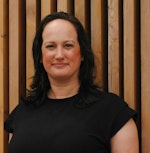A widely cited figure states that in the next five to 15 years, 50 percent of the current facilities management workforce could retire. With baby boomers exiting – and older members of Generation X not far behind – now’s the time for millennials looking for that next career step or members of Generation Z still in school or just starting out to consider a career in facilities management.
However, it can be difficult to get the right facilities management training and schooling. There aren’t many educational institutions with facility management programs, and preparing for and learning about the career can be a challenge.
“Our industry covers so much and there’s so many pieces that we touch, that it’s so hard to explain all that without overwhelming somebody.”
[Women in Facility Management Share Insights]
Unsure herself what she wanted to do in college, McGary tried different things, knowing she wanted a degree she could “use” after graduation. Deciding she wanted to go into architecture in graduate school, she prepared by getting into a facility management program during undergrad.
“I didn’t know what I was getting into, but I liked the variety we were learning about and decided to stick with it,” she says.
She believes that this lack of understanding keeps people from entering the profession. But with retirement rates as high as they are and the need to find qualified professionals strong, organizations need to take a proactive approach in attracting Gen Z and millennials to facilities management.
“It’s imperative that we begin this process to replenish in earnest right now because it takes time to build the programs necessary to close the gap,” McGary explains.
Companies Need to Take an Active Role
Companies in need of facilities managers now and in the near future must take notice and be proactive in the process to educate and recruit the next generation – both inside and outside of their organization.
“One of the biggest barriers I see is that a lot of companies say they need younger people and more facilities managers, but they aren’t willing to provide any sort of training,” McGary says.
Paid internships and mentor opportunities are ways that companies can give students and young professionals the real-world experience. Each have their own benefits and reasons why a company might support them based on their current needs:
Internships:
Benefits include having a feeder system of future employees, giving people experience while still in school and helping spread the word as to why facilities management is a good career path, explains Lisa Stanley, CEO of OSCRE, a collaboration for real estate professionals.
[On topic: Tips to Attract the Next Generation of Property Managers]
Mentorships:
Facilities management is complex with many different topics and areas to it. But mentoring is “absolutely critical,” notes Stanley, “and if organizations are looking at more senior people leaving, developing an effective mentoring program now is critical.”
For companies looking to “sell” facilities management to students or younger people not sure if it’s the right direction for them, McGary suggests framing the conversation around connecting people, workplace, process and technology. A career in facilities management is good for people who like:
- Buildings
- Solving problems and thinking on their feet
- The variety of learning and doing something different every day
“If so, you’d be perfect for this role,” McGary says. “As long as you have that kind of mindset, everything else is on-the-job training that you can pick up along the way.”
People in an adjacent role looking to explore facilities management or advance their careers should talk to their managers or see what their company offers. This could include mentorships or training, including attending conferences, setting aside time and money for certifications or seeking tuition reimbursement.
Working Together Across Generations
Getting the generations to work together cohesively is important. Each generation is known for specific traits that don’t apply to everyone in that generation, but all should be mindful. The current workplace spans four generations, from the retiring baby boomers to Gen X, millennials and those in Gen Z entering the workforce.
[Related: Designing for the Multi-Generational Workplace]
Ronni Schorr, global vice president of marketing for Circles with Sodexo Group, acknowledges that each generation has its unique strengths they bring to the workplace, which allows the different generations to complement each other and get the best out of everyone.
“I’ve seen this in facilities where the older facility managers are comfortable with one-to-one conversation and paper trouble tickets,” she says, and “millennials and Gen Z want everything digital. This cross of population is becoming more dependent on technology while learning best practices from boomers.”
William Hodges Hendrix, global workplace practice leader at Little Diversified Architectural Consulting, advocates organizations adapt to accommodate the younger employees. In 15 years, it will be a very different workforce, he notes, and we can prepare now by understanding them better.
[Millennials: Social Justice is the New Company Culture]
Characteristics of Gen Z that Hendrix notes are of importance to real estate and building management include:
- Job security and money
- Face-to-face interactions
- Sharing information with like-minded people
- Togetherness and connectivity
- Wanting to write their own job description
- Being realistic and having a Plan A and Plan B in place
As far as work experience, Hendrix sees that Gen Z employees are “looking for a place that meets what they are looking for. They want the stability and capability of making a difference. If you take what they want away, it might be a deal breaker and they may move.”
Some of the challenges that Gen Z faces is that the workplace may be designed for somebody other than them, Hendrix says. Sometimes change is slow, and this generation needs to be sympathetic and understanding to others in the workplace.
[Introverts Deserve Better Office Design]
He believes that the workplace should provide all generations the opportunity for flexibility, convenience, connectivity and authenticity. “One size does not fit all” for all employees, he notes.
Everyone needs to understand everyone else, Hendrix stresses, focusing on recognizing the differences and embracing them. “The interesting thing about the time that we live in is that we are much more tuned in to relishing the differences of the generations. We’re creating a much more diverse work environment, so we need to continue what we’re already doing.”
Stanley mimics that sentiment, noting that every person has something of value to add. Generations working together need to focus on convening, collaboration and cultivation. From the top down, leadership must encourage people to learn and explore new approaches that can help the organization.
“People who have the experience on the more senior side of the table should work with those who are relatively new to the industry who have developed the technical skills but don't necessarily have knowledge related to facilities management,” Stanley recommends. “It’s the perfect opportunity for marrying that skill set in a way that really helps the organization become a lot more powerful and more competitive in the marketplace.”
One area to consider bringing together generations is in how technology is used in the organization.
Gen Z doesn’t consider themselves tech-savvy, they’ve grown up using technology and don’t know another way. For an organization to stay competitive, make sure you offer the tools and technology as well as unique benefits that will attract and retain these young employees, Schorr says.
Facilities Management Benefits
To ensure a continuous pipeline of facilities management professionals, organizations need to be attuned to what younger employees want.
[Salary Check: 5 Top Facilities Management Jobs]
“Facilities management provides a very attractive opportunity for those who are seeking a new career in terms of its versatility and opportunity to be able to advance in an organization,” Stanley says.
Organizations typically focus their investment and expenses in three areas:
- Real estate
- Human capital
- Technology
Facilities management brings all three together.
“It’s where the workforce and the workplace can meet up in a way to advance an organization,” she notes. “The true change leaders are those that are coming in now and can change the future. Those that can rise up to that challenge will lead the industry forward.”
Two handpicked articles to read next:



